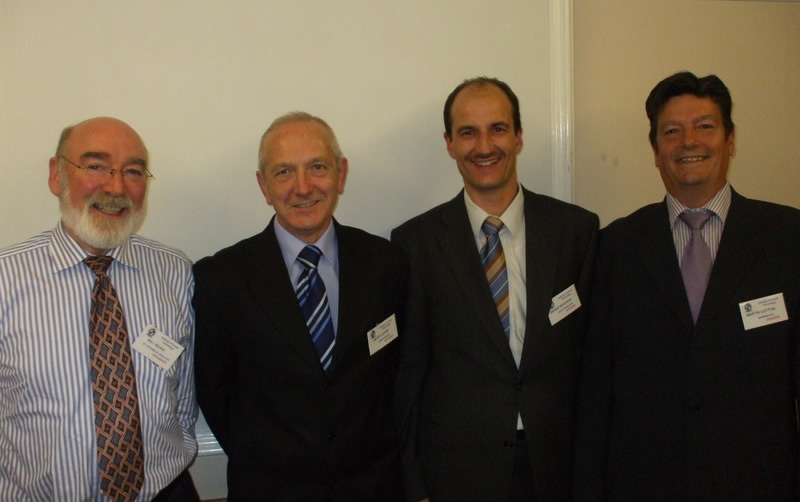Institute of Circuit Technology Evening Seminar
Arundel, UK, 6th October 2009
 There are traces of early Roman development in Arundel, West Sussex, on the south coast of England, although it developed mainly as a Saxon town, which was referred to in the Domesday Book in 1086. Today Arundel is a popular tourist destination famous for its castle and other historic buildings. Gaslight was first seen in the town in 1838 and electricity arrived during the 1930s. Since the 1970s, there has been a dynamic printed circuit board industry in the locality and although some familiar names have ceased trading during the last decade, there is always keen support for ICT’s evening technical seminars. Technical Director Bill Wilkie introduced a programme of three excellent presentations, on hole-plugging, high frequency materials and cost-effective panelisation, which were attentively received and which triggered some lively discussion both in the lecture room and in the bar afterwards.
There are traces of early Roman development in Arundel, West Sussex, on the south coast of England, although it developed mainly as a Saxon town, which was referred to in the Domesday Book in 1086. Today Arundel is a popular tourist destination famous for its castle and other historic buildings. Gaslight was first seen in the town in 1838 and electricity arrived during the 1930s. Since the 1970s, there has been a dynamic printed circuit board industry in the locality and although some familiar names have ceased trading during the last decade, there is always keen support for ICT’s evening technical seminars. Technical Director Bill Wilkie introduced a programme of three excellent presentations, on hole-plugging, high frequency materials and cost-effective panelisation, which were attentively received and which triggered some lively discussion both in the lecture room and in the bar afterwards.
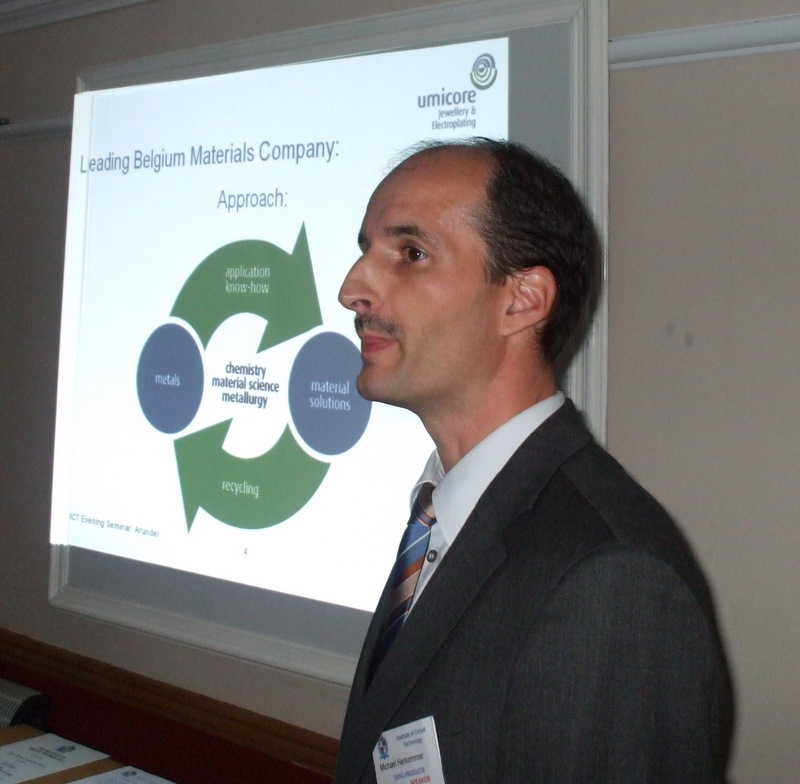
First presentation came from Michael Herkommer, Taiyo Product Manager with Umicore Galvanotechnic, who gave a very clear insight into via-hole plugging with epoxy pastes. A range of processing techniques was available to permanently fill holes for subsequent multilayer build-up, and the three key steps were plating, plugging and planarisation. He described the principle of button-plating: selectively pattern plating vias and pads only before tenting and etching, to leave a button of reinforcing copper standing proud around each hole which would subsequently protect the knee of the hole at the planarisation stage, preventing dish-down and maintaining specification on finished copper thickness. For successful plugging, the barrel of the hole needed to be free of nodules, residues or moisture. Three plugging techniques were described: vacuum plugging, roller coating and screen printing, and their relative merits compared. Vacuum plugging gave technically the best results, but investment cost was high. Roller coating could achieve high throughput, but required materials with long pot-life because of its large reservoir capacity. Screen or stencil printing gave the opportunity for selective plugging, but aspect ratio capability was limited, and air entrapment was a possibility. After the work had been plugged and cured, there were three options for planarisation: horizontal planarising was good for thin panels but had limited ability to conform with surface topography, manual grinding was low-cost but operator-dependent, and sanding machines were good for high-layer-count work. Plugging materials were generally single-component epoxies, very viscous and difficult to de-bubble. Some were available pre-filled in de-aerated cartridges, ready to be slotted directly into vacuum-plugging machines. For reliable results, the materials needed to exhibit a combination of high glass transition temperature and low thermal expansion with good peel strength and crack resistance. Herkommer discussed failure mechanisms and showed several examples of what could go wrong if material properties and processing procedures were not optimised.
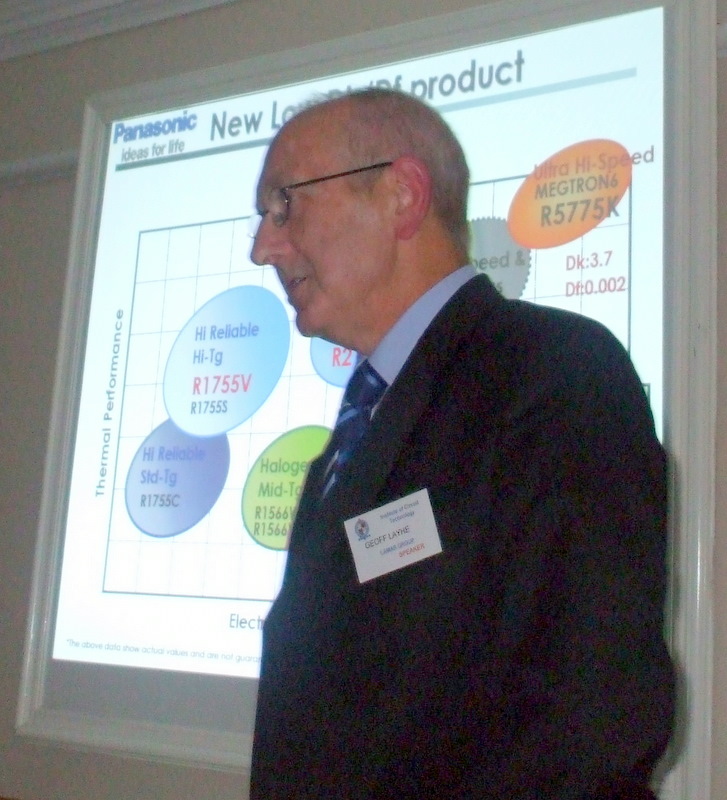 Geoff Layhe, Technical Manager of Lamar Group took the opportunity to describe in detail a new cost-effective, low dielectric constant, low loss laminate, manufactured by Panasonic and branded Megtron 4. The material was based on a functionalised polyphenylene oxide epoxy resin blend, with a dielectric constant of 3.7 at 10GHz and a loss factor of 0.005, considerably better than standard FR4, offering a cost-effective solution for high-frequency applications. Furthermore, with a glass transition temperature of 175degC and a decomposition temperature of 362degC, it was suitable for lead-free soldering processes. Layhe presented the results of conductive anodic filament resistance and interconnection stress testing, which indicated a high level of reliability, then discussed the practical aspects of bonding, drilling and de-smearing. The material could be processed through a similar route to FR4, although laminating temperature was higher. Because of its greater hardness and chemical resistance, increased drill wear and less weight loss at desmear were to be expected. A full range of laminate thicknesses and prepreg styles was available.
Geoff Layhe, Technical Manager of Lamar Group took the opportunity to describe in detail a new cost-effective, low dielectric constant, low loss laminate, manufactured by Panasonic and branded Megtron 4. The material was based on a functionalised polyphenylene oxide epoxy resin blend, with a dielectric constant of 3.7 at 10GHz and a loss factor of 0.005, considerably better than standard FR4, offering a cost-effective solution for high-frequency applications. Furthermore, with a glass transition temperature of 175degC and a decomposition temperature of 362degC, it was suitable for lead-free soldering processes. Layhe presented the results of conductive anodic filament resistance and interconnection stress testing, which indicated a high level of reliability, then discussed the practical aspects of bonding, drilling and de-smearing. The material could be processed through a similar route to FR4, although laminating temperature was higher. Because of its greater hardness and chemical resistance, increased drill wear and less weight loss at desmear were to be expected. A full range of laminate thicknesses and prepreg styles was available.
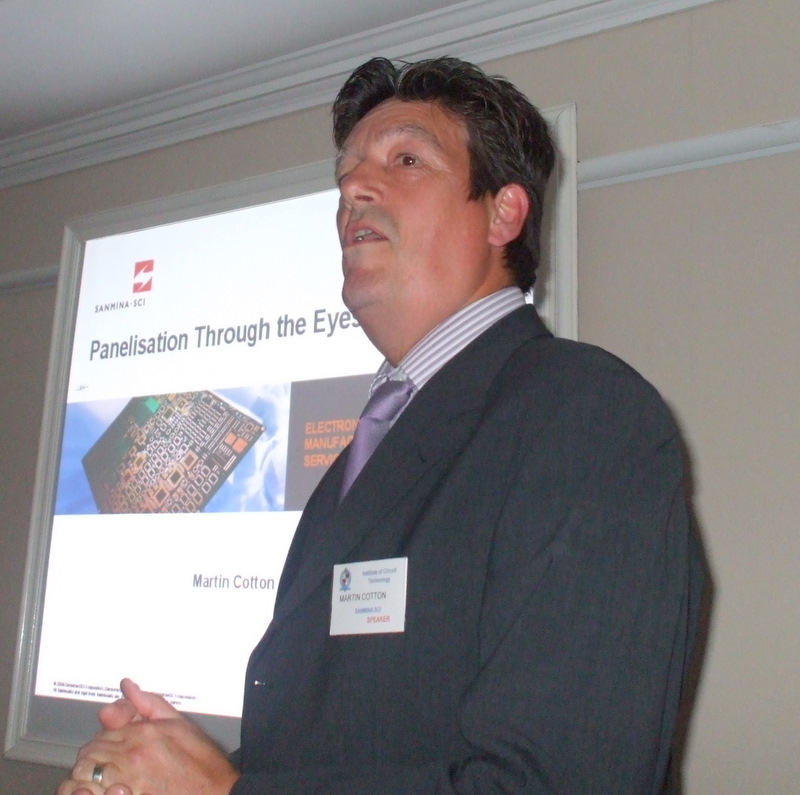 Never afraid to provoke a little controversy, Sanmina-SCI’s expert on PCB design, Martin Cotton, launched into the subject of panelisation from the viewpoint of the designer. He dismissed the term Design for Manufacture as implying a master-slave mentality, insisting that designers and manufacturers work together and listen to each other’s arguments in order to create a solution based on total cost of ownership. With lowest total cost as the objective, managers needed to allow PCB designers some scope to make real savings, not just run to a low-cost off-shore supplier. Panelisation was an important part of the whole value analysis scenario. Once the electronic function had stabilised and the material had been chosen, panelisation was the single most effective way of reducing cost. A fundamental part of the design process, it needed to be treated as such and included up-front before the metalwork and plastics design had been frozen. As a real exercise in material utilisation, he suggested the audience consider how to panelise a leather hide for shoe production. Demonstrating the complexity of the value analysis procedure practised by a major EMS corporation like Sanmina-SCI, he explained that decisions had to be made for a combination of process, commercial and strategic reasons. Without going deep into the mathematics, Cotton used the concept of the Golden Rectangle to illustrate his vision of “geometric harmony” in panelisation – a PCB with no waste was in harmony, and harmony equated to lower cost. The A-series of paper sizes was an example of the relevance of harmonic proportions. He demonstrated a series of actual examples of good and bad panelisation and implored designers to design panels rather than PCBs to gain cost benefits at all stages of the value chain.
Never afraid to provoke a little controversy, Sanmina-SCI’s expert on PCB design, Martin Cotton, launched into the subject of panelisation from the viewpoint of the designer. He dismissed the term Design for Manufacture as implying a master-slave mentality, insisting that designers and manufacturers work together and listen to each other’s arguments in order to create a solution based on total cost of ownership. With lowest total cost as the objective, managers needed to allow PCB designers some scope to make real savings, not just run to a low-cost off-shore supplier. Panelisation was an important part of the whole value analysis scenario. Once the electronic function had stabilised and the material had been chosen, panelisation was the single most effective way of reducing cost. A fundamental part of the design process, it needed to be treated as such and included up-front before the metalwork and plastics design had been frozen. As a real exercise in material utilisation, he suggested the audience consider how to panelise a leather hide for shoe production. Demonstrating the complexity of the value analysis procedure practised by a major EMS corporation like Sanmina-SCI, he explained that decisions had to be made for a combination of process, commercial and strategic reasons. Without going deep into the mathematics, Cotton used the concept of the Golden Rectangle to illustrate his vision of “geometric harmony” in panelisation – a PCB with no waste was in harmony, and harmony equated to lower cost. The A-series of paper sizes was an example of the relevance of harmonic proportions. He demonstrated a series of actual examples of good and bad panelisation and implored designers to design panels rather than PCBs to gain cost benefits at all stages of the value chain.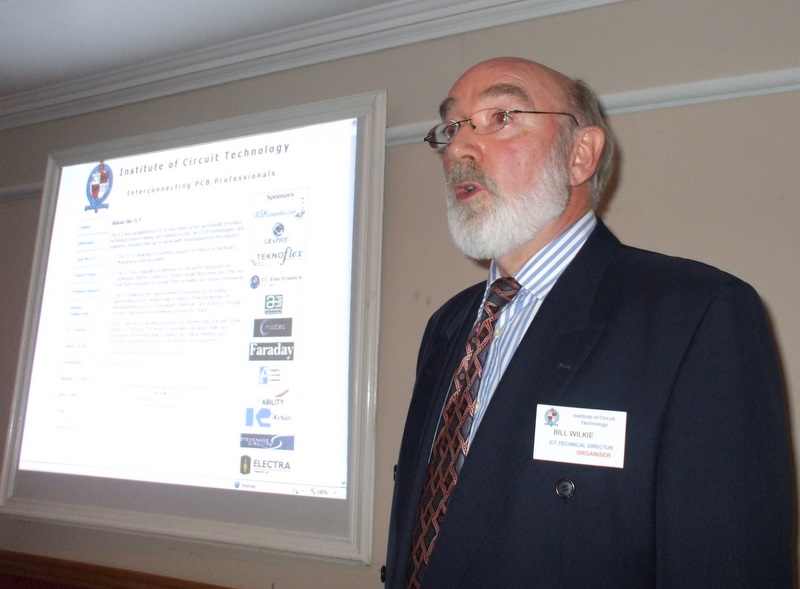 Another successful ICT seminar: technically informative and a valuable networking opportunity for the delegates. In his closing remarks, Bill Wilkie thanked all who attended, and Lamar Group for supporting the event.
Another successful ICT seminar: technically informative and a valuable networking opportunity for the delegates. In his closing remarks, Bill Wilkie thanked all who attended, and Lamar Group for supporting the event.
Pete Starkey
October 2009
